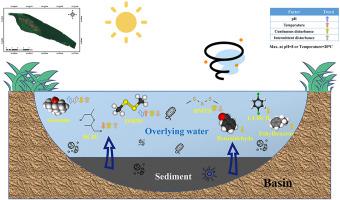Chemosphere ( IF 8.1 ) Pub Date : 2020-11-21 , DOI: 10.1016/j.chemosphere.2020.129068 Cheng Peng , Xuchen Yan , Xianyun Wang , Yunying Huang , Lei Jiang , Peng Yuan , Xuefei Wu

|
Endogenous pollution from sediments is gradually becoming a critical pollution source of the drinking water reservoir. Odorants can be released from sediments into the overlying water which further deteriorates the water quality of the drinking water reservoir. In this work, we set the sediment-overlying water systems under various water pH (6.5, 8 and 9), temperature (4, 20 and 30 °C) during 30 days and intermittent or continuous hydraulic disturbances (at 100 r/min or 200 r/min) in 5 days, and investigated the dynamic release of odorants from the drinking water reservoir sediments via using headspace solid-phase microextraction (HSPME) and gas chromatography-mass spectrometry (GC-MS). The result shows that weakly alkaline environment slightly but not significantly increased the concentration of dimethyl disulfide (DMDS) in the overlying water. Furthermore, low temperature promoted the release of bis(2-chloroisopropyl) ether (BCIE) and geosmin to 108.36 and 18.98 ng/L, respectively, while high temperature facilitated the DMDS release to 20.33 ng/L. Notably, hydraulic disturbances drastically elevated the level of seven odorants released from the sediments. Specially, benzaldehyde exhibited highest concentration at 260.50 ng/L. The continuous disturbance greatly enhanced the release of benzaldehyde, DMDS, dimethyl trisulfide (DMTS), BCIE and 1,4-dichloro-benzene (1,4-DCB) from sediments with a positive disturbance speed-dependence. However, the intermittent disturbance promoted higher level of geosmin in the overlying water compared to the continuous disturbance. Only continuous hydraulic disturbance at high speed could lead to the release of ethylbenzene from sediments, which was up to 4.89 ng/L in 12 h.
中文翻译:

上海最大的饮用水水库沉积物中的气味释放:pH,温度和水力干扰的影响
来自沉积物的内源性污染正逐渐成为饮用水水库的关键污染源。气味会从沉积物中释放到上层水中,这进一步恶化了饮用水水库的水质。在这项工作中,我们将沉积物覆盖水系统设置为在30天的各种水pH(6.5、8和9),温度(4、20和30°C)和间歇性或连续性水力扰动下(100 r / min或200 r / min),并在5天内使用顶空固相微萃取(HSPME)和气相色谱-质谱(GC-MS)研究了饮用水水库沉积物中气味的动态释放。结果表明,弱碱性环境略微但并未显着增加上覆水中二甲基二硫(DMDS)的浓度。此外,低温促进双(2-氯异丙基)醚(BCIE)和土工胺的释放分别达到108.36和18.98 ng / L,而高温促使DMDS释放至20.33 ng / L。值得注意的是,水力扰动极大地增加了从沉积物中释放出的七种臭味剂的水平。特别是,苯甲醛的最高浓度为260.50 ng / L。连续扰动极大地增加了沉积物中苯甲醛,DMDS,三硫化二甲基(DMTS),BCIE和1,4-二氯苯(1,4-DCB)的释放,且扰动速度具有正相关性。然而,与连续扰动相比,间歇扰动在上覆水中促进了更高的土臭味素水平。只有高速持续的水力扰动才能导致乙苯从沉积物中释放出来,









































 京公网安备 11010802027423号
京公网安备 11010802027423号